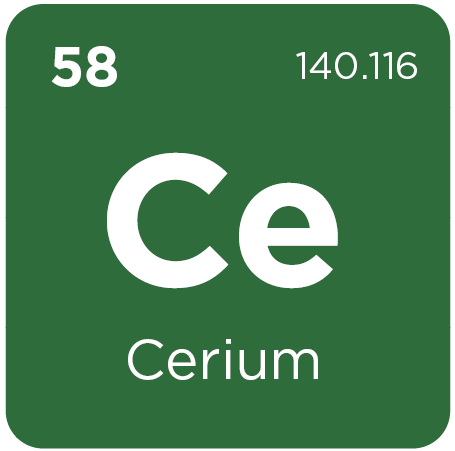by Forest Anderson
This article was published in the spring 2024 issue of our newsletter.
Cerium may not be used frequently in wastewater treatment, but it is worth considering for its multifaceted characteristics. It works well as a coagulant to remove nutrients, a catalyst to break down organic pollutants, and an antioxidant to prevent excess ROS formation.
Cerium is a rare earth element that was first identified in 1803. It was named for the dwarf planet Ceres, which itself was named after the Roman goddess of agriculture and fertility. Coincidentally, cerium is effective at removing nutrients from agricultural runoff.

Both cerium chloride salts and cerium oxide nanoparticles (CeO2 NPs) can be used as coagulants to remove organic pollutants and nutrients like phosphorus. They can be added to a clarifier, aeration tank, or mixing tank like other coagulants.
Typically, coagulation is achieved using a combination of a polymer and a chemical like alum. With cerium-based coagulants, you only need one product, and you don’t need to use much of it. Cerium also doesn’t affect alkalinity the way that alum does.
CeO2 NPs and cerium salts have a high surface area and reactivity, making them more efficient as an adsorbent and coagulant. Cerium causes suspended solids and phosphates to adsorb, floc tightly, and precipitate. The nature of these bonds means that less water is trapped, so the volume of sludge is considerably decreased. This reduces the amount of sludge pressing, drying, and/or hauling that is needed.
Three wastewater systems in the Green Mountain State use cerium-based coagulants, and it has led to significantly reduced phosphorus concentrations and lower turbidity in their effluent. I visited one system where cerium helped achieve a 95 percent removal of phosphorous, resulting in effluent with orthophosphate concentrations of less than 1 mg/L.
Cerium compounds also function as catalysts in the degradation of organic pollutants such as dyes, pharmaceuticals, phenolic compounds, solvents, acids, and petroleum hydrocarbons. High concentrations of these chemicals will cause a toxic event for a wastewater system. CeO2 NPs breaks down these chemicals through redox and catalytic reactions.
Cerium, in the form of cerium oxide, is an antioxidant, so it can neutralize reactive oxygen species (ROS). These are byproducts of normal cellular respiration, but increase rapidly during environmental stress such as intense UV exposure or high temperatures. Sudden increases in ROS damage living cells, so CeO2 NPs can protect the microorganisms used in wastewater treatment.
In addition to its applications in wastewater treatment, cerium can be used in drinking water treatment as well. For example, it could be used in place of a polymer for surface water filtration. Cerium is not toxic to humans or the environment.
The upfront cost of cerium-based products is higher than traditional coagulants and phosphorus removal compounds, but it could save money in the long run. One cerium product replaces two coagulation products, and only a small dose of cerium is needed to achieve results.
Down the road, the reclamation of biosolids may become increasingly important for wastewater systems. A sludge reclamation process could allow facilities to recover and reuse cerium. As research in this field continues, cerium-based technologies are likely to play an increasingly important role in enhancing the efficiency and sustainability of wastewater treatment.

